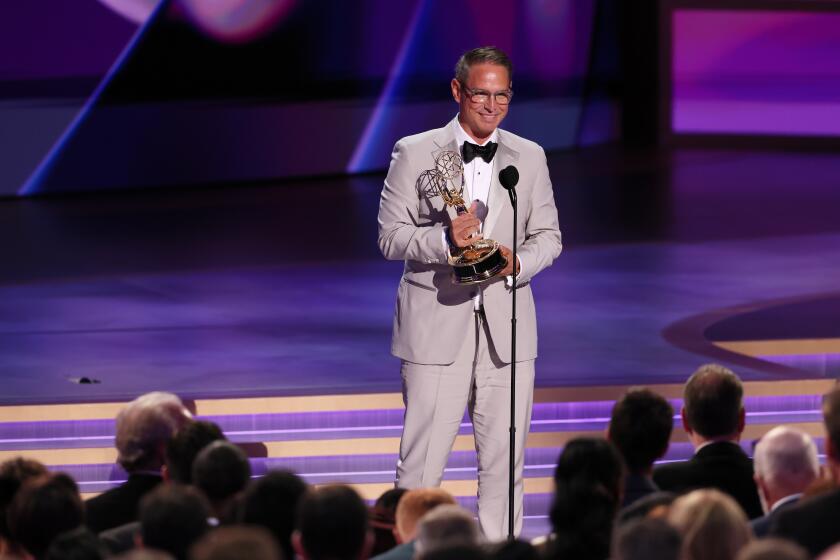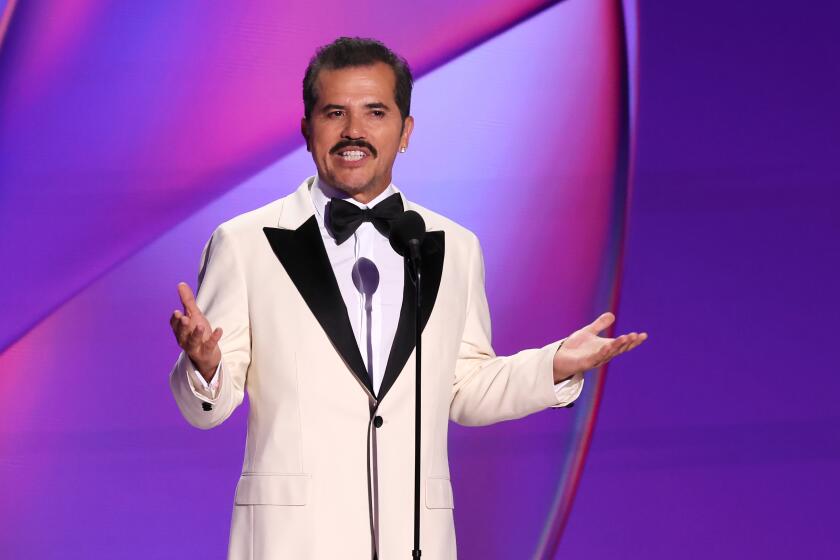A ‘Different’ Stroke of Genius Earns an Emmy
- Share via
Einstein, Gandhi, Picasso and friends proved an unbeatable team, as the second-ever Emmy for a television commercial went to Apple Computer’s “Think Different” ad. The spot, narrated by actor Richard Dreyfuss and featuring black-and-white film clips of 20th century notables, was executed in-house by Los Angeles-based TBWA Chiat/Day.
The ad shows several-second clips of revered world figures, often in whimsical, unstaged moments. Dreyfuss narrates an ode to “the crazy ones” who end up changing the world.
The award, presented Saturday, marks a triumphant return for the agency (formerly Chiat/Day, bought by Omnicon in 1995), which regained the Apple account from L.A.’s BBDO just a year ago.
Despite its financial woes in recent years, Apple has continued to trade on its image as a brand favored by creative types. Some would say too much so: Though years of high-profile commercials such as its legendary “1984” spot--also produced by Chiat/Day--have appealed to a niche market of creative professionals, the business and mass consumer markets have steadily moved away from Apple toward PCs.
The “1984” spot--which aired just once, during the 1984 Super Bowl--depicts an athletic woman running into a room full of drones watching a man’s image on a giant video screen. She hurls a hammer, smashing the image and liberating the crowd from the grip of Big Brother (a.k.a. IBM). The ad was controversial, but it led to a hugely successful launch for Apple’s Macintosh.
The mission last year in creating the award-winning ad was to bolster loyalty among core Apple users while spreading the word to others who like to think of themselves in the company of creative geniuses.
Jennifer Golub, a 10-year veteran of Chiat/Day, got her first-ever directing credit on the commercial. There has been grumbling from other ad people that the spot was merely a “clip job,” but Golub insists that as much or more creativity went into the spot as any other up for an Emmy. (See sidebar for the other nominees.)
The Times interviewed Golub this week about the spot she directed and produced.
*
Q: How unusual is it for an ad to be completely executed in-house at an agency?
A: It’s very unusual. I initiated the project. [Top account executive] Lee Clow felt I had my finger on the pulse as to what the tone and temperament should be, so I took it on.
Q: Was this particular campaign instrumental in your agency getting the Apple business back?
A: I really don’t know; I don’t think I can answer that. I do know that [Apple’s] main concern was how to sort of recapture their audience. I think [the spot] absolutely appeals to both current and potential customers.
Q: What do you think it is about the spot that really appealed to people?
A: I think the thing that really touches people’s hearts is the mixture of imagery you’ve seen before and haven’t seen before. We tried to capture moments in people’s lives where they were at the precipice of discovery. The message that being different is something to rejoice in touches people very deeply.
Q: How did you go about identifying those to be featured in the commercial, and getting permissions?
A: Internally [at the agency], we generated a list of people we thought changed the course of the 20th century and had gone about it in an individual way. Then we verified it with [Apple co-founder and interim Chief Executive] Steve Jobs.
We tried our best to represent various sectors: artists, entrepreneurs, scientists, architects, both women and men. We procured virtually everyone we went after. Only a few turned us down. With Nelson Mandela, for example, we were told he couldn’t be part of the commercial because he was currently in office.
It was a real team effort, and it came together with breathtaking speed; we were working around the clock. I personally did a lot of undercover work. I got permission [to use Gandhi’s image] by tracking down his grandson. For the Dalai Lama, I called information for Damsala, India, and asked for his phone number.
*
Q: It must’ve also been quite a task to get the footage.
A: Yes, and [the spot is] really a tribute to the work of a number of extraordinary filmmakers. It includes footage from Leon Gast’s “When We Were Kings,” of Muhammad Ali. Penny Baker’s beautiful footage of Bob Dylan. . . .
I’ve never seen an object as unique as this within a commercial context. I think it almost serves as a piece of public service work.
Q: Have you gotten a lot of feedback?
A: Extraordinary feedback, particularly from the education community. We got a note from the father of a young boy who wants to be a poet and felt like he was an outsider at school. His father said [the commercial] gave him a certain kind of validation.
Q: So how does it feel to win? And do you plan to direct more?
A: I’m really deeply honored, and I think the agency is very proud.
I can’t really answer whether I’ll direct again. I’m flexible, and I have a versatile set of skills. I just finished a monograph on the architect Albert Frey.
More to Read
The complete guide to home viewing
Get Screen Gab for everything about the TV shows and streaming movies everyone’s talking about.
You may occasionally receive promotional content from the Los Angeles Times.






